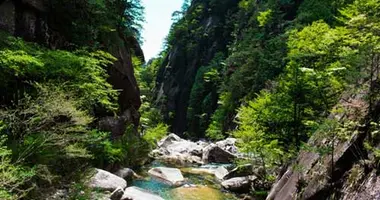Takasaki Guide Gunma
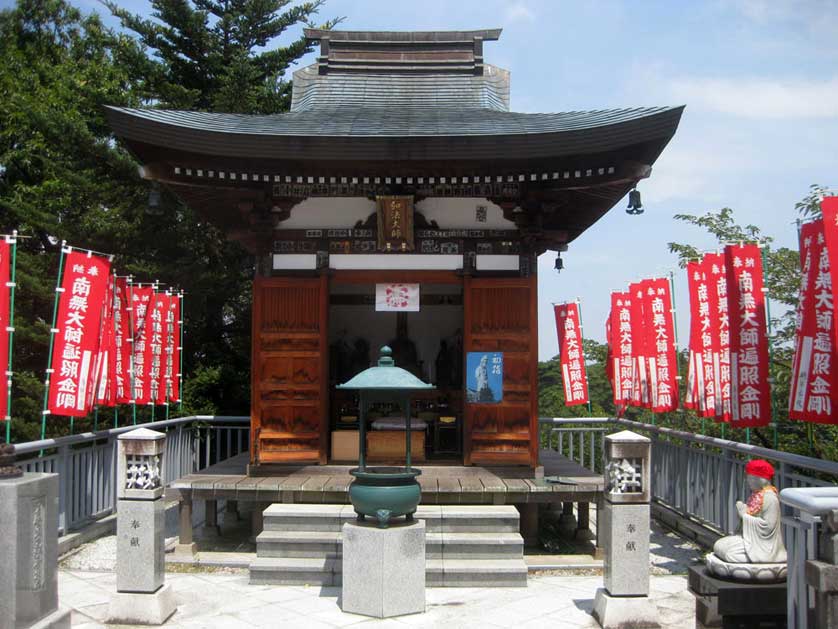
Byakue Kannon temple complex, Takasaki, Gunma
Nestled in the heart of Gunma Prefecture, Takasaki is a vibrant city that offers a unique blend of historical significance, cultural attractions, and natural beauty. Known as the home of daruma dolls and the impressive Byakue Kannon statue, Takasaki serves as a gateway to popular hot spring resorts and UNESCO World Heritage sites. With its rich heritage, diverse attractions, and convenient location just 50 minutes north of Tokyo, Takasaki is an ideal destination for travelers seeking an authentic Japanese experience. This guide will explore the city's must-visit attractions, local specialties, and practical travel information to help you make the most of your visit to this often overlooked gem.
Discovering Takasaki's Daruma Doll Heritage
Takasaki is renowned as the birthplace of the daruma doll, a traditional Japanese good luck charm. These iconic dolls, usually painted red and featuring a distinctive rounded shape, are deeply ingrained in the city's cultural identity. The Shorinzan Darumaji Temple, located just a short distance from the city center, is the spiritual home of the daruma doll tradition.
Visitors to the temple can explore its beautiful grounds, adorned with maple and ginkgo trees, and marvel at the hundreds of daruma dolls displayed along the veranda of the main building, known as Reifudo. The temple's Kannon hall, with its elegant thatched roof, is another highlight not to be missed.
For those interested in the craftsmanship behind these beloved figurines, a visit to Daimonya Co., Ltd. is a must. This workshop, run by fourth-generation master craftsman Nakada Sumikazu, offers visitors the opportunity to learn about the significance of daruma dolls and even decorate their own. The experience provides a unique insight into Japanese culture and the meditative process of creating these symbolic objects.
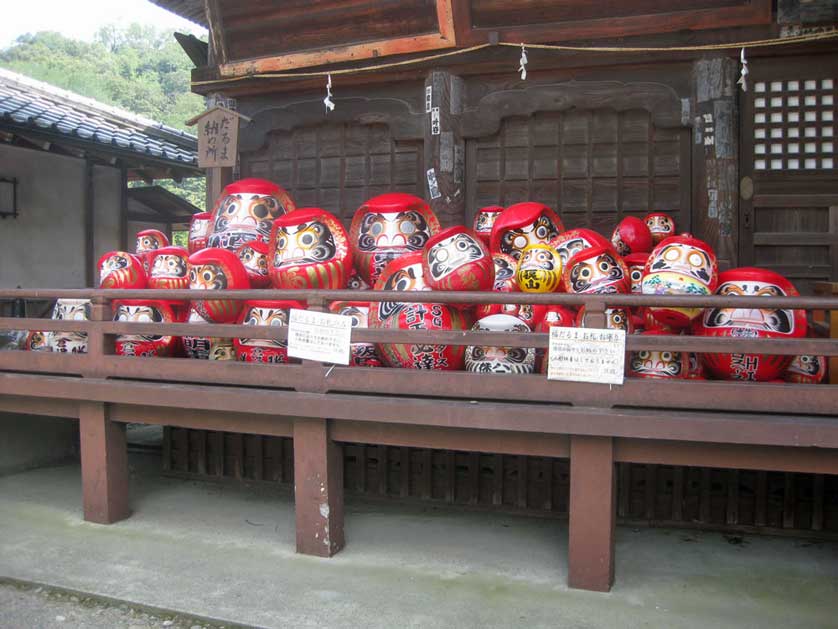
Collection of Daruma for sale, Byakue Kannon, Takasaki, Gunma
Exploring Kannonyama and the Byakue Kannon Statue
One of Takasaki's most iconic landmarks is the Byakue Kannon statue, a towering 41.8-meter-high figure of the Goddess of Mercy that overlooks the city from atop Kannonyama hill. This impressive white-robed Kannon is not only a symbol of Takasaki but also one of the largest of its kind in Japan.
Visitors can climb 146 steps inside the statue, ascending nine levels to reach its shoulders. From this vantage point, you'll be rewarded with breathtaking panoramic views of Takasaki and the surrounding landscape. The statue is particularly beautiful during cherry blossom season in spring and when the autumn foliage turns the surrounding gardens into a vibrant tapestry of reds and golds.
The statue is located within the grounds of Jigenin Temple, where visitors can pray to the 20 enshrined Buddhas placed within the Kannon figure. The temple complex also hosts the Mandoue Festival in late August, during which thousands of candles illuminate the mountainside, creating a mesmerizing spectacle.
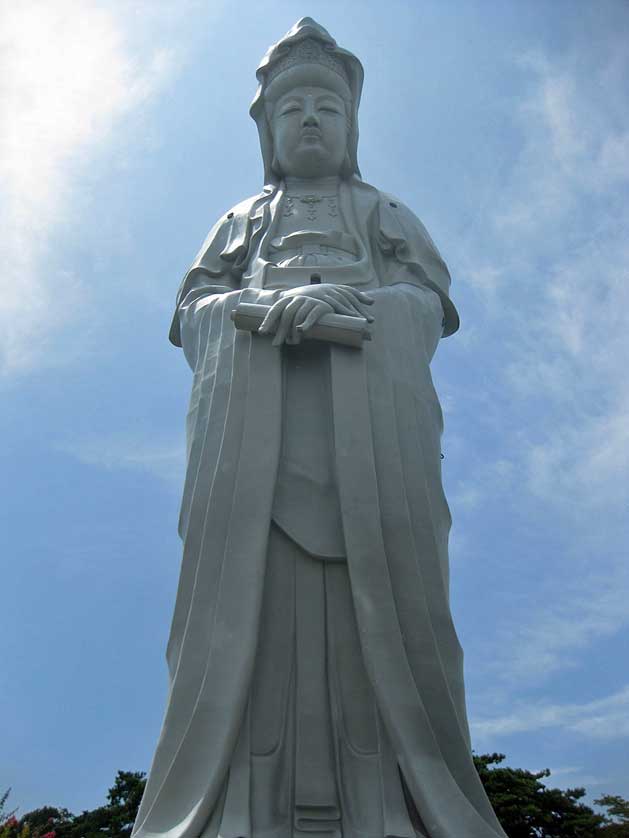
Byakue Kannon from below, Takasaki, Gunma
Takasaki's Historical and Cultural Attractions
Beyond its famous daruma dolls and Kannon statue, Takasaki boasts a rich tapestry of historical and cultural attractions. The Hodota Kofun-gun, a cluster of ancient burial mounds dating back to the 5th and 6th centuries, offers a fascinating glimpse into Japan's prehistoric past. The Hachimanzuka Kofun, in particular, has been painstakingly restored to its original appearance, complete with smooth stones and rows of haniwa clay figurines.
Art enthusiasts will appreciate the Kamitsukenosato Museum of Archaeology, which houses a remarkable collection of artifacts excavated from the kofun tombs. The museum's exhibits provide valuable insights into the civilization that built these impressive structures.
For those interested in Japan's industrial heritage, the Tomioka Silk Mill, located in the neighboring city of Tomioka, is a must-visit attraction. This UNESCO World Heritage Site played a crucial role in Japan's modernization during the Meiji Period and offers visitors a chance to explore well-preserved buildings and learn about the country's silk industry.
Day Trips and Nearby Destinations
Takasaki's strategic location makes it an excellent base for exploring the wider Gunma Prefecture. Nature lovers can venture to the Jomo Sanzan, a trio of famous mountains consisting of Mt. Akagi, Mt. Myogi, and Mt. Haruna. Each mountain offers unique hiking experiences and spectacular views.
For those seeking relaxation, the nearby hot spring resorts of Ikaho Onsen and Shima Onsen provide the perfect opportunity to unwind. Ikaho Onsen is known for its 365 stone steps lined with traditional ryokan and shops, while Shima Onsen boasts the title of Japan's first nationally certified hot spring for health benefits.
History buffs might enjoy a visit to the Meganebashi Bridge, an impressive red-brick structure built in 1893 along the Usui Pass. Though no longer in use as a railway bridge, it remains a popular spot for photographers and hikers alike.
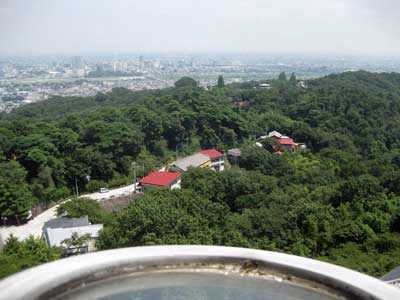
View from top of Byakue Kannon, Takasaki, Gunma
Local Cuisine and Dining Experiences
Takasaki's culinary scene is surprisingly diverse, with a particular emphasis on pasta dishes. In fact, the city is known as the "Pasta Town" of Japan, boasting the highest number of pasta restaurants per capita in the country. This unique food culture culminates in the annual "King of Pasta" competition, held every November, where local Italian restaurants compete to showcase their best dishes using locally produced ingredients.
Beyond pasta, Takasaki offers a range of local specialties. The city's abundant wheat production has given rise to various "konamono" or flour-based foods, including udon, okirikomi, and fried manju. Visitors should also look out for products labeled "Takasaki Sodachi", a brand that certifies high-quality local agricultural and livestock products.
For a unique dining experience, consider visiting Tokiwaso, a restaurant specializing in kaiseki cuisine made with konnyaku, a starchy vegetable jelly that is a specialty of Gunma Prefecture. This innovative approach to traditional Japanese cuisine offers a truly memorable meal.
Transportation and Accommodation in Takasaki
Takasaki is easily accessible from Tokyo, making it an ideal destination for a day trip or a longer stay. The fastest way to reach Takasaki is by taking the Joetsu or Hokuriku Shinkansen from Tokyo Station, which takes about 50 minutes. Alternatively, regular trains on the JR Takasaki Line or Shonan-Shinjuku Line offer a more economical option, with a journey time of around two hours.
For accommodation, Takasaki offers a range of options to suit various budgets and preferences. Business travelers might appreciate hotels like the Hotel Metropolitan Takasaki or the Takasaki Washington Hotel Plaza, both conveniently located near the station. For a more traditional experience, consider staying at one of the ryokan in nearby Ikaho Onsen or Shima Onsen.
Seasonal Events and Best Times to Visit
Takasaki hosts a variety of events throughout the year, making it an attractive destination in any season. Some highlights include:
- The Shorinzan Daruma Market on January 6th and 7th, where visitors can purchase daruma dolls for the new year.
- The Takasaki Spring Festival in early April, featuring cherry blossom viewing and cultural performances.
- The Takasaki Festival in early August, a lively event with portable shrines, floats, and the largest fireworks display in northern Kanto.
- The Takasaki Music Festival from mid-September to mid-October, showcasing various musical performances throughout the city.
While Takasaki can be enjoyed year-round, the best times to visit are during cherry blossom season in early April and during the autumn foliage season in late October to early November. These periods offer the most picturesque views of the city and its surroundings, particularly around the Byakue Kannon statue and the city's parks.


















